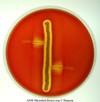Blood, Brain, Urine Flashcards
2 types of blood borne infections
Obligate Intracellular Bacteria (live in RBCs) -*Rickettsia, (Ehrlichia, Anaplasma) -small, gram-negative (do not stain well) -coccobacilli (rod) Spirochetes -Borrelia
Obligate Intracellular bacteria - characteristics
-Transmitted via arthropod vector -geography, exposure to vector, type of rash is important for differentiating these: *Where does the rash begin, what areas of the body does it cover? *Rickettsia Ehrlichia Anaplasma
Rickettsia rickettsii / geography
Rocky Mountain Spotted Fever -name is misleading more common in southEastern U.S. due to presence of ticks
Rickettsia rickettsii / vector
Arthropod: dog tick, wood tick (reservoir: Wild rodents) note the tick mother can pass it to her offspring (Transovarial transmission)
Rickettsia rickettsii / clinical presentation
rash: *centripetal*: starts on wrists, arms, palms, ankles, sole and then moves in towards the trunk rash – pin-point red dots – due to damage of blood vessels (Bacteria proliferate in the endothelial lining of small blood vessels causing hemorrhages) (conjunctival redness, myalgia)
Rickettsia rickettsii / Diagnosis
microimmunofluorescence MIF: detects antibodies (may take up to 2 weeks)
Rickettsia akari / vector
Arthropod: *mite* (invertebrate, similar to ticks) (Reservoir: mice)
Rickettsia akari / geography
rickettsialpox
Rickettsia akari / clinical presentation
Mild, self-limiting, fever *pox-like rash*: Papule at site of bite progresses to a vesicle 9-14 days later: high fever, severe headache, chills, photophobia, more vesicles appear on the body which crust
Rickettsia prowazekii / geography
Epidemic typhus (fast spread, think lice jumping) poverty, overcrowding, war, natural disasters
Rickettsia prowazekii / vector
Vector: body lice (Louse - wingless insect) reservoir = humans
Rickettsia prowazekii / clinical presentation
8 days incubation: then sudden fever 4-5 days later*rash*: small pink macules on upper trunk (torso) then spreads outward - *NO rash on palms, soles or face*
Rickettsia typhi / geography
Endemic typhus - occurs at a low level all the time (NOT EPIDEMIC) *Geography*: worldwide, in -warm, humid areas -U.S. Gulf coast
Rickettsia typhi / vector
Vector: flea (Reservoir: rodents)
Rickettsia typhi / clinical presentation
rash on chest and abdomen Low mortality even in untreated
Orientia tsutsugamushi / geography
Scrub typhus (found in sandy soil / areas of heavy scrub vegetation) endemic to: Geography: *Asia and southwest pacific
Orientia tsutsugamushi / vector
Vector: chiggers: soil (reservoir: rodents)
Orientia tsutsugamushi / clinical presentation
High fever, headache, myalgias, scab at bite *flat maculopapular rash develops*
Borrelia burgdorferi / geography (Spirochetes)*
Lyme disease: most commonly reported tick borne illness in the U.S geography *All along the east coast and along the great lakes (could be that the ticks are traveling with birds)
Borrelia burgdorferi / mode of transmission
Vector: tick (Reservoir: white-footed mice, white-tailed deer)
Borrelia burgdorferi / clinical presentation
Stage 1: localized -Bulls-eye rash and flulike symptoms; lasts 2-3 weeks Stage 2: disseminated -Fatigue, migratory joint (polyarthralgia - pain in more than one joint), and muscle pain Stage 3: chronic (could have these symptoms for life) -Chronic arthritis, encephalitis
Borrelia burgdorferi / Diagnostics
2 Test approach (no simple test exists, can lead to misdiagnosis) 1. enzyme immunoassay or immunofluoresence assay 2. if postive, follow up with a western blot to confirm (consider alternate diagnosis)
2 forms of Relapsing Fever, explain transmission:
- 15 species of Borrelia -vector: soft tick -endemic (rodents spread it) 2. Borrelia recurrentis -vector: louse -epidemic (humans, living in conditions of poor hygiene, spread it)
What form of Relapsing fever would you get in a RUSTIC CABIN (cabin is falling apart, in poor condition)
endemic (rodent spread - vector) soft tick Borrelia spp. (15)







